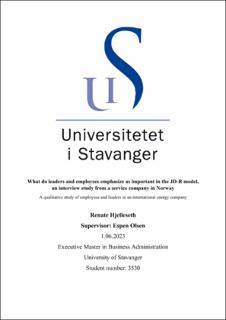| dc.description.abstract | When looking at the international organisation Gallup’s ‘State of the Global Workplace 2022’ report, we find that 60% of the world’s workers are emotionally detached at work, and 19% are miserable (Gallup 2022). As the demand for labour in Norway is very high due to the post-Covid pandemic, showing unemployment lowering to the low level of 1.6% of the workforce as of September 2022 (Nav), the increased focus for most employers is to keep employees motivated and keep low retention. In many sectors, new roles have become part of the workforce, like the chief happiness officer (CHO) or head of well-being. Their focus is to create an environment where individuals thrive.
So, what is important for both employees and leaders to increase motivation and reduce strain? There are no clear answers, as there are many factors at stake both within and outside the organisation. Therefore, this study aims to gain a broader insight into what employees and leaders in an international energy company emphasise as important from a JD-R perspective. We want to focus on getting a better knowledge of engagement and well-being drivers by examining the importance of various factors with a specific focus on demands and resources.
A quality study was conducted with interviews among employees and their leaders. The questions aimed at enhancing understanding regarding the importance and impact of the main point of the model. The main points of the model are job resources (i.e. supervisory coaching, autonomy, social support, teamwork, performance feedback, and opportunities for development and growth within the organisation), and job demands (i.e. conflict at work, job responsibility, time pressure, role conflicts, and workload). We also aim to understand the role of leadership and basic needs.
The results of the study disclosed that engaging leadership can have a real impact on basic needs both directly and indirectly through leadership. A significant correlation was found between the leader’s emphasis on ensuring visibility for all team members and the employee’s experience of being seen as generally accepted. Interestingly, when individuals were questioned about what was most important for them and their employees, they all mentioned social climate and support. Additionally, we discovered that job motivation was accomplished through a combination of job resources and demands. Our research further found that individuals recalled being highly motivated during periods characterised by clear expectations, demanding tasks, and well-defined deadlines. | |
